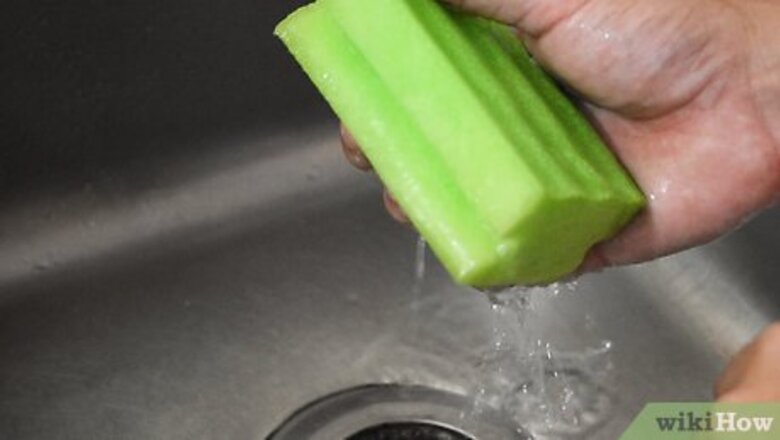
views
Microwaving Your Sponge
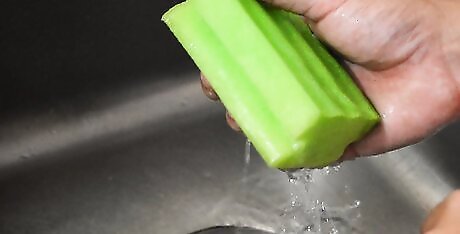
Soak the sponge with water and put it in a microwave-safe bowl. Run the sponge under tap water for 30 seconds, letting it become completely saturated. Don’t squeeze or wring the sponge, since you want to keep as much water in it as possible. Place the wet sponge in a glass, plastic, or ceramic bowl that's safe to go in the microwave. If you don't have a microwave-safe bowl, you can place the sponge on a paper towel to catch any water that comes out of the sponge in the microwave.Caution: Never microwave sponges that have metal or plastic scrubbers, as these can be fire or electrocution hazards in the microwave. It's best to wash these sponges using the dishwasher or by soaking them in a bleach solution.
Place the sponge and a cup with 0.5 cups (120 mL) of water in the microwave. Position the bowl containing the sponge and the cup of water next to each other in the microwave as close together as possible. If your microwave has a spinning table, make sure both items are near the center. The cup of water will ensure that the sponge stays moist in the microwave. If it becomes too dry, the sponge can melt or catch on fire.
Microwave the sponge for 1-2 minutes. Start by microwaving for one minute, which can kill up to 99% of all bacteria in the sponge. If the sponge smells bad when you open the microwave, you'll have to re-heat it. Make sure it’s still wet; re-soak the sponge if it isn't. Then, microwave it for an additional 30-60 seconds. Some sponges naturally smell bad when they’re hot. If the sponge smells like plastic, you don’t need to reheat it.
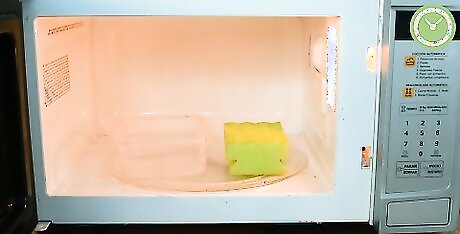
Let the sponge cool in the microwave for 10-15 minutes. Open the microwave door and let the sponge sit for at least 10 minutes before you try to pick it up or remove it from the bowl. Then, squeeze out any excess water from the sponge. Remember, the sponge will be extremely hot once you remove it from the microwave. Don’t try to pick it up or remove it from the bowl until it has cooled down.
Cleaning in the Dishwasher
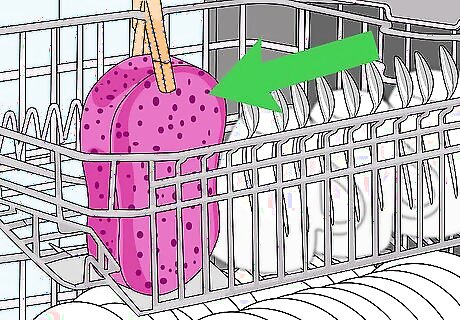
Put your sponge in the dishwasher. Place it on the top rack or in the utensil section. To secure it on the top rack, you may want to clip it directly to the rack with a clothes pin. You can put it in with a load of dishes. Make sure there aren't any large chunks of food on it, but you don't need to clean it ahead of time.
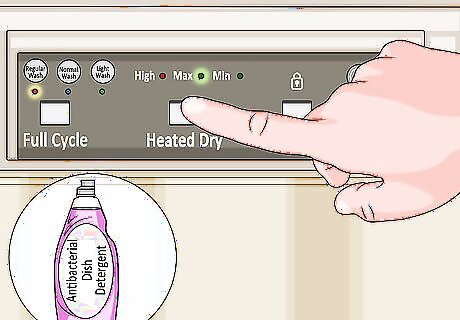
Run the dishwasher. Make sure to use the heated dry setting for maximum sterilization. Run it through the full cycle on a regular dish setting; just make sure the water is hot. Use the same dish detergent that you normally would, preferably one that is antibacterial.
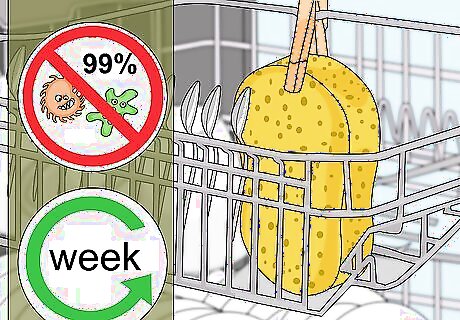
Repeat weekly. Make sure to do this at least once a week. You can simply throw in your sponge each time you run a load of dishes. The dishwasher will both clean and sanitize your sponge, killing over 99% of germs and removing any grime. Wash and sterilize your sponge immediately if you use it to clean a surface that has touched raw meat or fish. Sterilized sponges still need to be replaced every 2-8 weeks depending on how frequently they are used.
Using the Stove
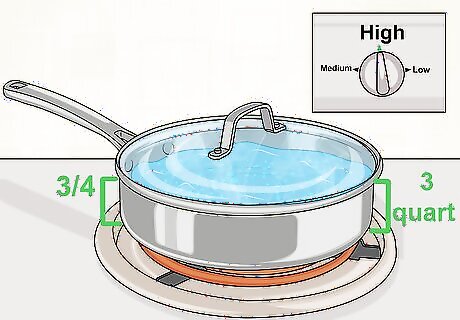
Boil a pot of water. Use a 3-quart pot and fill it 3/4 to the top with cold water. Bring the water to a boil by placing it on the stove. Turn the burner on high until the water boils. Keep the pot covered to heat the water faster.
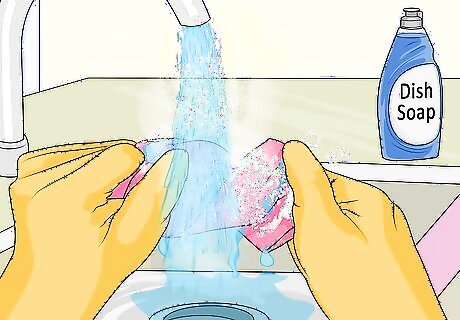
Rinse your sponge. Clean off any excess food or grime that is sticking to it. You want the sponge to be fairly clean before immersing it in water so that it isn't soaking in anything dirty. Simply run it under warm water and clean it with a little dish soap. Wring out any excess water.
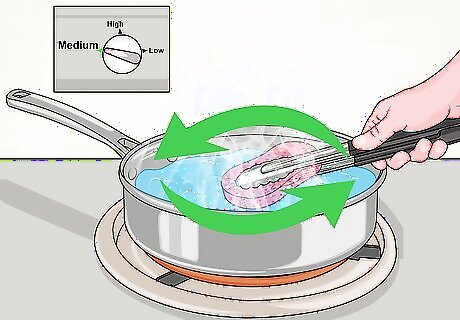
Place the sponge in the water carefully. Make sure not to burn your hands. Remove the pot's lid and slowly lower the sponge into the water. You can place the sponge in the water using a cooking spoon or tongs to avoid burning your fingers. The sponge should be covered in water. Make sure it doesn't rest on the bottom of the pot or it could melt. To keep it from sticking to the pot, stir it occasionally. Turn down the burner down to medium-high so that the water doesn't boil over.
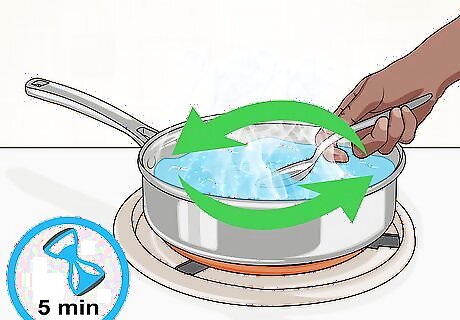
Keep the sponge in the water for 5 minutes. This is enough time to reduce bacteria from millions to a safe number. Keep the pot uncovered and make sure the sponge isn't sticking to the edges.
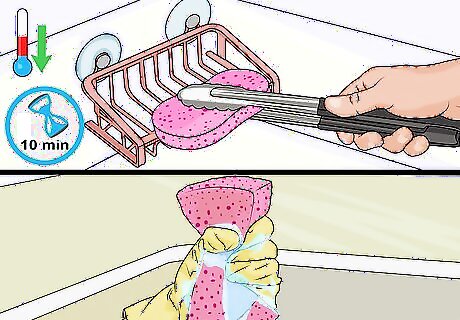
Remove the sponge with a spoon or tongs. It will be very hot. Place it on a clean surface to thoroughly air-dry, such as a dish rack. This will keep bacteria from multiplying. After it has cooled for about 10 minutes, you can wring out the sponge to remove excess water and help it to dry faster.
Soaking and Washing the Sponge
Make a solution of 10% bleach in a bowl. Fill a glass, plastic, or ceramic bowl with 9 parts water and 1 part bleach, and stir the mixture thoroughly. Make sure there’s enough of the solution to submerge the sponge completely in the water. Be careful when handling bleach as it can be harmful if left on your skin for too long. This solution is strongly diluted, but you should wear a pair of rubber cleaning gloves to protect your skin from irritation.
Soak the sponge in the bleach for 5-10 minutes. As it soaks, use a wooden spoon or spatula to press on the sponge to work the solution throughout the sponge. Every 2-3 minutes, pick it up and squeeze the liquid out of the sponge before putting it back in the solution. This helps ensure the bleach completely penetrates the sponge, helping the removal of stains and debris.
Remove the sponge from the solution and rinse it thoroughly. After at least 5 minutes, pull the sponge out of the solution and squeeze all of the liquid out. Then, rinse the sponge with warm tap water for 30 seconds, squeezing and wringing it to clear out the bleach and any loose debris.Tip: If your sponge smells bad after you rinse it, do another bleach soak, but add 1 part white vinegar to the mixture to neutralize the smell of bleach.
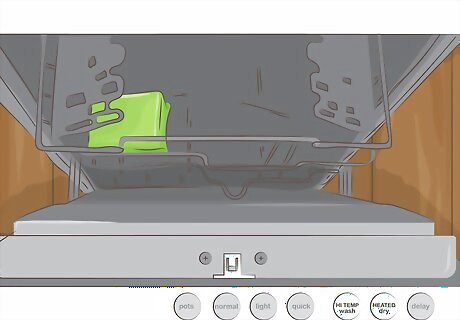
Place the sponge on the top rack of the dishwasher for an extra deep clean. Set the dishwasher to the longest, hottest cycle, and make sure the sponge is resting on the wire rack. Select a cycle with heated drying to kill the most germs and bacteria. This method works for almost any type of sponge, including synthetic and metal scrubbers.
Using Vinegar
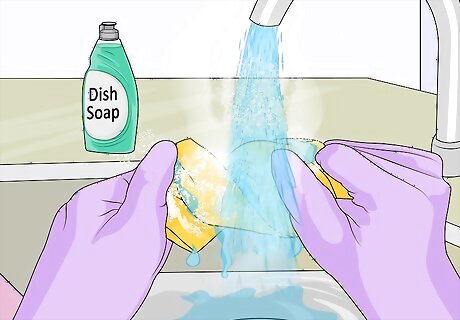
Rinse the sponge. This will remove any residue or dirt. Simply run under warm water and add a little dish soap to get rid of grease. Make sure to do this prior to placing the sponge in the vinegar.
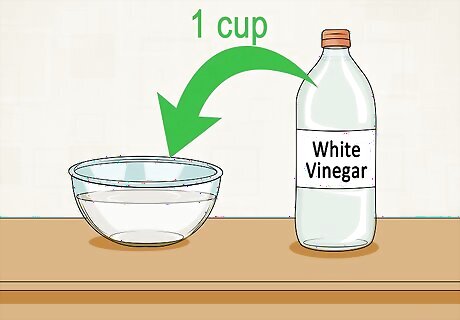
Fill a small glass bowl with a cup of vinegar. Use white vinegar because it doesn't have any residue and will dry without a scent. Make sure the vinegar is high enough in the bowl to fully cover the sponge.
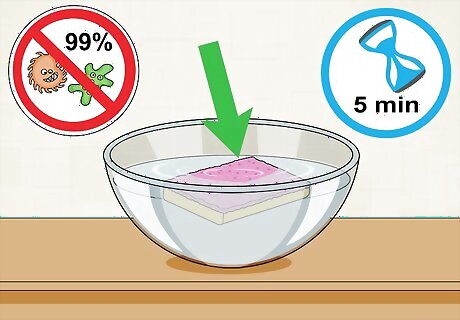
Keep the sponge in submerged in vinegar for at least 5 minutes. Place the sponge in the vinegar so that it is fully covered. If you have the time, allow it to soak overnight for best results. Vinegar contains acetic acid that effectively kills over 99 percent of germs in five minutes. It also eliminates odors.
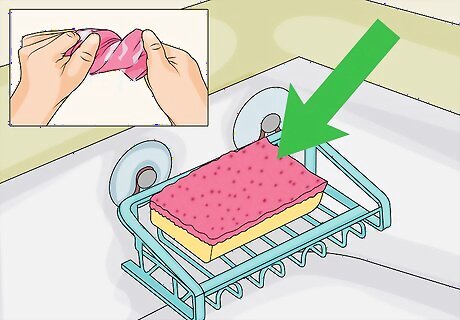
Squeeze out excess vinegar. Simply remove your sponge from the bowl and wring it out. Allow it to air-dry on a dish rack. There's no need to rinse it. The vinegar will dry without an odor. Your sponge is ready to use! Over 99 percent of germs have been effectively eliminated.
Using Sponges Properly
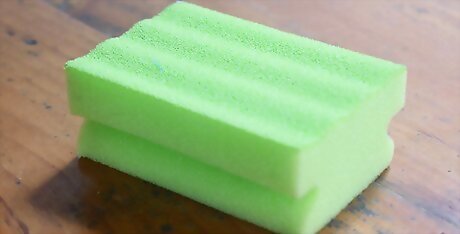
Replace your sponge every 1-2 weeks. Sponges don’t last forever, and the longer you have them, the more bacteria they hold. Try to replace your kitchen sponge weekly if you use it every day, or biweekly if you use it less often. If your sponge starts to smell bad or becomes discolored, throw it away and replace it immediately.
Place the sponge on a dish to air dry between uses. Squeeze the sponge to remove excess moisture after you rinse it. Then, leave uncovered it on a dish or the edge of the sink so the sponge can dry completely in between uses. Mold and bacteria can multiply quickly in a wet sponge, especially in a warm, damp environment.
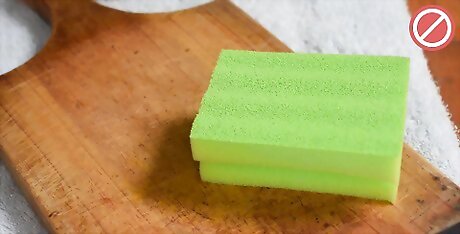
Avoid using the sponge on surfaces that have touched raw meat. Instead of using a sponge, use other materials to clean up raw juices from meat. Opt for a dishcloth, washcloth, or paper towel to wipe down cutting boards and counters. Disinfectant wipes are also a good option for wiping down counters that need to be cleaned. Sponges have crevices that can harbor bacteria easily, but cloths and wipes are less absorbent.














Comments
0 comment